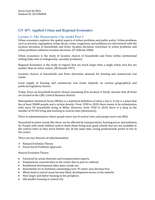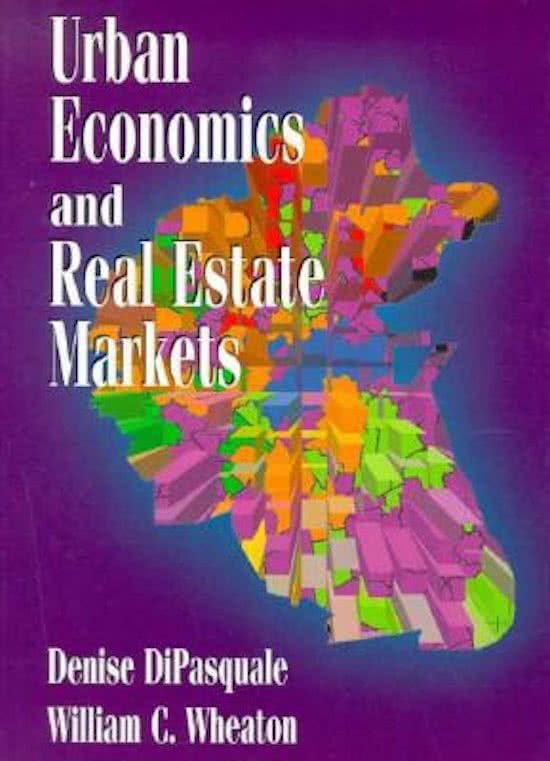Joven Liew Jia Wen
Student ID: 201506858
GY 457: Applied Urban and Regional Economics
Lecture 1: The Monocentric City model Part 1
Urban economics explores the spatial aspects of urban problems and public policy. Urban problems
such as poverty, segregation, urban decay, crime, congestion, and pollution are intertwined with the
location decisions of households and firms: location decisions contribute to urban problems and
urban problems influence location decisions. (O’ Sullivan 2000)
Urban economics is the study of location choices of households and firms within institutional
setting (take note of endogeneity, causality problems)
Regional Economics is the study of regions that are much larger than a single urban area but are
smaller than an entire nation. (McDonald 1997)
Location choices of households and firms determine demand for housing and commercial real
estate.
Local supply of housing and commercial real estate depends on various geographical and
political/regulatory factors.
Today, focus on household location choices (assuming firm location is fixed). Assume that all firms
are located at the CBD, Central Business District.
Metropolitan Statistical Areas (MSAs) is a statistical definition of what a city is. A city is a place that
has at least 50000 people and a certain density. From 1950 to 2010, there seems to be urbanization
with more US households living in MSAs. However, from 1950 to 2010, there is a drop in the
number of US HH living and working in central cities (downtown).
There is suburbanization where people move out of central cities and people move into MSA.
Household location trends like these can be affected by transportation, housing prices and pollution.
Ex. People with small children tend to think about living near good schools that are not available in
the central cities so they move further out. At the same time, young professionals prefer to live in
the centre.
There are two theories of suburbanization
Natural Evolution Theory
Fiscal Social Problems Approach
Natural Evolution Theory
Favoured by urban theorists and transportation experts
Employment concentration in the centre due to port or railhead
Residential development takes place inside out
Households try to minimize commuting costs centre area develop first
When land in central areas become filled, development moves to the suburbs
New larger and better housing in the periphery
Old smaller housing in central city
,Joven Liew Jia Wen
Student ID: 201506858
Centrally located units filter down to lower income groups
Income stratified neighbourhoods
Process is reinforced by transportation innovations
Car is a luxury good so only the rich HH are first to adopt this automobile and there is a move of
rich HH to suburbs especially when there is crime and pollution in the city centre
As a result, decentralization of residential activity employment decentralization
Firms follow the population to the suburbs to minimize wages
Suburbanisation becomes a self-reinforcing process
Emphasis of Natural Evolution theory
Distance of residential sites to central work places
Effects of rising real income over time
Demand for new housing and land
Heterogeneity of housing stock
Transportation costs and innovation of intra-urban transportation
Changes over time in comparative advantage of different income groups at commuting longer
distances to work
Fiscal Social Problems approach
Emphasis on fiscal and social problems of central cities
High taxes, low quality public schools and other services, racial tensions, crime, congestion and
pollution
Push factors to let people move to the suburbs
Tiebout’s (1956) famous model
Households vote with their feet and groups with homogenous preferences move to the same
location
Affluent HH avoid redistributive taxes by residing in areas of low taxes but housing are
expensive so eventually only rich HH live there, leading to income stratified communities. Ex.
Switzerland
Process is reinforced by exclusionary and fiscally motivated land use controls
Minimum lot size restrictions: Some municipalities state that by moving in, you have to buy a
certain size of land which only large and rich HH can afford. Ex. Los Angeles suburbs
Discriminate against income indirectly through zoning
Eventually, natural evolution and fiscal social factors interact
Monocentric model – commuting cost differences within urban area must be balanced by
differences in the price of living space
Land is intermediate input in the production of housing
Commuting or access to a place of employment (CBD) is the only locational advantage that is
considered
Commuting to CBD gives rise to Ricardian rent
Assume that HH are identical, fixed no. of workers per HH, all HH commute to the CBD
Firms (Employers) have no explicit role except that employment is at a singular centre, Central
Business District (CBD)
Government has no role: no zoning, no rent control
,Joven Liew Jia Wen
Student ID: 201506858
Developers have no role
The one living in the periphery will consume a bigger house as price of housing is lower further
away from CBD
Price compensate for commuting cost
Housing price p decreases in distance from CBD
Housing consumption q is increasing in distance from CBD (Consumers who live further out
must be compensated for long and costly commutes)
Housing price decrease in commuting cost
Housing price p are increasing in income
Housing is produced with inputs of land l and capital N: H(N, l)
Revenue from a building is therefore p * H(N, l)
Producer profit = p*H –iN – rl
Capital/Land ratio = S = N/l
r will adjust such that profits per square meter of land = 0
land rent r decreases in distance from CBD
structural density S decreases in distance from CBD
Lower land rent is required at greater distance to compensate producers for lower price per
square foot of housing
Population density D is a decreasing function of distance
Pros and Cons of the Monocentric model
Model does a good job in predicting the observed regularity in internal structure of cities.
Predictions appear to recapitulate reality ex. Houses further from CBD are indeed bigger
Predictions are broadly consistent with empirical findings though recently challenged in the US
with more polycentric cities emerging such as Los Angeles
Analysis however cannot explain intercity differences in spatial structures
In reality, firms also compete for land and not just located at the CBD
At some point, farmers will outbid HH and tell us where the edge of the city is.
Land use regulations in reality ex. Green Belt in London
Additional equilibrium conditions will allow us to have meaningful comparative static analysis and
allow for intercity differences.
Model predictions differ in terms of assumptions of closed city vs. open city
DiPasquale-Wheaton, Chapter 3: The Urban Land Market Rents and Prices
The markets for land and housing are often referred to as completely product differentiated
because each product sold in the market (every house or location) is unique.
By definition, the supply of land at each location is fixed hence it is quite price inelastic. Demand is
quite elastic, with respect to price.
Theory of compensating differentials assumes that only demand considerations determine relative
value of land or housing at different locations. Supply of land sets overall level of prices.
Ricardo (1817) Ricardian rent
,Joven Liew Jia Wen
Student ID: 201506858
Housing and land are more expensive at better locations. This holds whether we consider
natural locational amenities like lake or man-made locational advantages like distance to
employment.
Monocentric city (Alonso, Mills and Muth) with one employment centre and commuting to the
place of employment is the only locational advantage
Ricardian rent is the payments a tenant would offer for housing
Assumes that density of development is fixed
HH commute along a direct line from their place of residence
HH are identical and no. of workers per household is fixed
Assume that housing is occupied by households who offer the highest rent and land is allocated
to that use yielding the greatest rent
Decrease rent as one moves out of city centre exactly offsets the increase commuting cost
If housing rents do not exactly offset, HH that live closer have more income to spend on other
goods (x) and HH in further locations will want to move closer. Demand increases and rent at
closer locations will rise. When rent exactly offsets commuting cost, HH have no incentive to
move: spatial equilibrium
Ricardian rent = y – kd – x
Rent for a unit at the edge of the city = land rent raq + structure rent (annualized cost of
construction) c
Rent gradient of housing = R (d) = (raq + c) + k (b –d) where k(b-d) is difference in commuting
cost at urban edge and those at location b
Urban land rent
Housing and land rent are higher in interior locations because of higher savings in commuting
cost
Slope of land rent gradient is –k/q
Population, Land supply and Ricardian rent
Many cities developed historically to serve as ports therefore they have a semicircular structure
ex. Boston (270◦), Chicago (180◦), Bombay (30◦)
Stylised city land supply v ranges from 0 to 1, v = 1 means a circle.
Central land rents should be higher in cities with greater density even as house rents fall
Spatial separation
Urban and housing markets tend to naturally separate different households or land uses
spatially
When there are multiple groups of households there is no requirement that members of one
group must enjoy the same welfare as the other group. Group 1 dislikes commuting intensely
and Group 2 mind less so Group 1 has higher cost of travel k.
Group 1 are willing to pay higher rents to be closer to city centre and there will be a location m
where landlords are willing to rent to either group
, Joven Liew Jia Wen
Student ID: 201506858
HH with higher income demand more land since land is a normal good. When 2 groups differ on
income, outcome depends completely on income elasticities of land consumption as opposed to
commuting costs. With income elastic land demand and inelastic commuting costs, higher income
HH have larger lots and only slightly greater commuting costs. They have steeper bids and locate
centrally.
Growth and rents
Jump from housing rent to housing prices are affected by long term interest rates, expected
future growth of current rent, risk or variance and federal tax treatment of real estate
Ricardian model suggests that growth of city population affects growth of urban housing rent
As population size increases, city border grows
As population grows at a constant rate, increase in housing rent will not be constant over time.
In fact, the largest % increase in housing rent occur at the urban edge
In any location that is already developed, price of housing is equal to PDV of rental income
stream.
When there is no expected growth in the city as a whole, the capitalization rate is simply
interest rate and is constant across all locations in the city
As the city grows spatially from population increases, capitalization rate is less than interest
rate and is no longer constant across locations.
Housing prices: Empirical Evidence
In real world, housing structures differ significantly because of history, climate and varying
regional preferences
In comparison to Minneapolis, many Los Angeles homes have swimming pools and air
conditioning. Data on average sale prices by metropolitan area may not be a good indicator of
differences in housing prices between markets where the typical unit varies so much.
Size of metropolitan area, expected rate of growth and cost of constructing structures affect
prices positively
Conclusions





